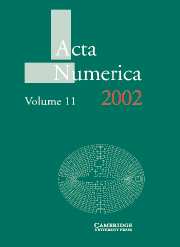Book contents
- Frontmatter
- Contents
- 1 Structured inverse eigenvalue problems
- 2 Subdivision schemes in geometric modelling
- 3 Adjoint methods for PDEs: a posteriori error analysis and postprocessing by duality
- 4 Finite elements in computational electromagnetism
- 5 Splitting methods
- 6 Topological techniques for efficient rigorous computation in dynamics
- 7 The immersed boundary method
- 8 Numerical methods for large eigenvalue problems
7 - The immersed boundary method
Published online by Cambridge University Press: 21 May 2010
- Frontmatter
- Contents
- 1 Structured inverse eigenvalue problems
- 2 Subdivision schemes in geometric modelling
- 3 Adjoint methods for PDEs: a posteriori error analysis and postprocessing by duality
- 4 Finite elements in computational electromagnetism
- 5 Splitting methods
- 6 Topological techniques for efficient rigorous computation in dynamics
- 7 The immersed boundary method
- 8 Numerical methods for large eigenvalue problems
Summary
This paper is concerned with the mathematical structure of the immersed boundary (IB) method, which is intended for the computer simulation of fluid–structure interaction, especially in biological fluid dynamics. The IB formulation of such problems, derived here from the principle of least action, involves both Eulerian and Lagrangian variables, linked by the Dirac delta function. Spatial discretization of the IB equations is based on a fixed Cartesian mesh for the Eulerian variables, and a moving curvilinear mesh for the Lagrangian variables. The two types of variables are linked by interaction equations that involve a smoothed approximation to the Dirac delta function. Eulerian/Lagrangian identities govern the transfer of data from one mesh to the other. Temporal discretization is by a second-order Runge–Kutta method. Current and future research directions are pointed out, and applications of the IB method are briefly discussed.
Introduction
The immersed boundary (IB) method was introduced to study flow patterns around heart valves and has evolved into a generally useful method for problems of fluid–structure interaction. The IB method is both a mathematical formulation and a numerical scheme. The mathematical formulation employs a mixture of Eulerian and Lagrangian variables. These are related by interaction equations in which the Dirac delta function plays a prominent role. In the numerical scheme motivated by the IB formulation, the Eulerian variables are defined on a fixed Cartesian mesh, and the Lagrangian variables are defined on a curvilinear mesh that moves freely through the fixed Cartesian mesh without being constrained to adapt to it in any way at all.
- Type
- Chapter
- Information
- Acta Numerica 2002 , pp. 479 - 518Publisher: Cambridge University PressPrint publication year: 2002
- 86
- Cited by



